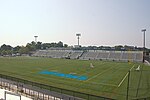Johns Hopkins University (often abbreviated as Johns Hopkins, Hopkins, or JHU) is a private research university in Baltimore, Maryland. Founded in 1876, Johns Hopkins was the first U.S. university based on the European research institution model.The university was named for its first benefactor, the American entrepreneur and Quaker philanthropist Johns Hopkins. Hopkins' $7 million bequest to establish the university was the largest philanthropic gift in U.S. history up to that time. Daniel Coit Gilman, who was inaugurated as Johns Hopkins's first president on February 22, 1876, led the university to revolutionize higher education in the U.S. by integrating teaching and research. In 1900, Johns Hopkins became a founding member of the American Association of Universities. The university has led all U.S. universities in annual research and development expenditures for over four consecutive decades ($3.18 billion as of fiscal year 2021).While its primary campus is in Baltimore, Johns Hopkins also maintains ten divisions on campuses in other Maryland locations, including Laurel, Rockville, Columbia, Aberdeen, California, Elkridge, and Owings Mills. The two undergraduate divisions, the Zanvyl Krieger School of Arts and Sciences and the Whiting School of Engineering are located on the Homewood campus in Baltimore's Charles Village neighborhood. The medical school, nursing school, Bloomberg School of Public Health, and Johns Hopkins Children's Center are located on the Medical Institutions campus in East Baltimore. The university also consists of the Peabody Institute, Applied Physics Laboratory, Paul H. Nitze School of Advanced International Studies, School of Education, Carey Business School, and various other facilities. The university also has graduate campuses in Italy, China, and Washington, D.C.As of October 2019, 39 Nobel laureates and one Fields Medalist have been affiliated with Johns Hopkins's faculty and alumni. Founded in 1883, the Blue Jays men's lacrosse team has captured 44 national titles and plays in the Big Ten Conference as an affiliate member. The university's other sports teams compete in Division III of the NCAA as members of the Centennial Conference.






